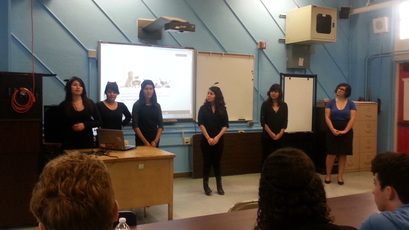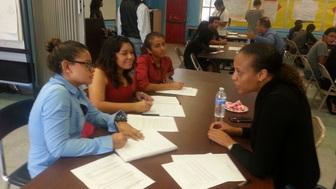 Students presenting their app idea about a lost and found app for animals.
Students presenting their app idea about a lost and found app for animals. I have a secret.
I am no longer the most knowledgeable person in my classroom. I am not sure who owns that title - but more often than not it is not me when it comes to teaching Scratch, App Inventor, and soon Game Design and Computer Science Principles. I feel a bit guilty about it - but it is just not possible anymore.
Should I spend hours researching and testing everything I do before I feel I am ready to present it to the class? Some may say yes but I would like those same people to tell me when I should find the time for that. Or a better question - if I have to work this hard - what are the students doing? Shouldn't they be doing the problem solving? Shouldn't they be part of the research?
I think about how I continue to learn now that I am no longer a student. There is no one telling me what to do, I have to figure it out for myself and that is now the philosophy I bring into the classroom. I am teaching the students to do their own research, crowd sourcing, problem solving and not to fear good old fashion trial and error.
I want my classroom to be as real world as possible. The classroom is not the place where I show off my knowledge. Rather this is where the students learn how to problem solve and find solutions to their questions. The goal for my students is to be successful human beings. The goal is not for them to jump through my hoops. Yes, this means sometimes my timelines get altered as they try to figure things out. I often think that sometimes as teachers we end up giving the answers because we are rushed to get through the material or prove to them we know what we are doing. This may make things go faster but it does not help learning and does not create the experiences and steps the students truly need in order to "learn" something.
I used to feel embarrassed or flustered if I could not answer my students' questions right away. However, now I don't let it bother me. The truth is that the field of technology and computer science is constantly changing as new software and tools are developed. I try to stay connected. I go to conferences. I meet with my advisory board. I read articles and ask questions from my tech geek husband. However, there is no way to be well versed in it all.
My confidence in inquiry grew this past year when I started teaching Exploring Computer Science which stresses inquiry as one of the three major components of teaching the curriculum. It is also stressed when I go to professional developments about developing critical thinking and using project based learning. I have found that now that I don't easily have the answers I am much stronger at asking questions in order to get the students to think and begin to ask more questions on their own.
Maybe that is my secret.
Now, instead of feeling insecure when I don't know something, I celebrate the thinking and inquiry coming from the students. "Yes, that is a good question," I respond. "How can you find out the answer? Where would you look? What keywords would you use to research it? Have you asked other people in the room if they have found a solution?" Now they are learning to trust themselves to find the answers. They know that questions are great and solutions are there for them to figure out on their own. And that is what I call successful learning.
Originally published in Good Inc
Pull out tips:
Tip: Free yourself from the expert trap
Instead of spending hours researching and testing every last lesson and skill get the students to research and test with you. There is no one telling adults and workers how to do every last bit of a job, you must learn to figure it out. Get the students to gain confidence and problem solving skills by doing their own research and crowd-sourcing and not to fear good old-fashioned trial and error.
Tip: Make the classroom as real world as possible
The classroom is not the place to show off your knowledge. Rather it is where the students learn how to problem-solve and find solutions to their questions. The goal is for them to learn to be successful not to jump through hoops. Give them open ended challenges or small challenges and step back and let them figure out using their resources.
Tip: Don’t rush the timeline and give out answers
Sometimes teachers end up giving students the answers because they are rushed to get through the material or prove to students that they know what they are doing. This may make things go faster but it does not help learning and does not create the experiences the students need in order to truly "learn" something.
Tip: Celebrate the inquiry of the students - It is okay if you as the teacher don’t know all the answers
Don’t feel embarrassed or flustered if you can’t answer students' questions right away. The truth is that the field of technology and computer science is constantly changing as new software and tools are developed. Try to stay connected and read articles However, there is no way to be well-versed in it all.
Instead celebrate the thinking and inquiry coming from the students. Put the student in the power seat to find the answers. This will encourage students to think and begin to ask more questions on their own.
This way students learn to trust themselves to find the answers. They know that questions are great and the solutions are there for them to figure out on their own. And that is successful learning.
I am no longer the most knowledgeable person in my classroom. I am not sure who owns that title - but more often than not it is not me when it comes to teaching Scratch, App Inventor, and soon Game Design and Computer Science Principles. I feel a bit guilty about it - but it is just not possible anymore.
Should I spend hours researching and testing everything I do before I feel I am ready to present it to the class? Some may say yes but I would like those same people to tell me when I should find the time for that. Or a better question - if I have to work this hard - what are the students doing? Shouldn't they be doing the problem solving? Shouldn't they be part of the research?
I think about how I continue to learn now that I am no longer a student. There is no one telling me what to do, I have to figure it out for myself and that is now the philosophy I bring into the classroom. I am teaching the students to do their own research, crowd sourcing, problem solving and not to fear good old fashion trial and error.
I want my classroom to be as real world as possible. The classroom is not the place where I show off my knowledge. Rather this is where the students learn how to problem solve and find solutions to their questions. The goal for my students is to be successful human beings. The goal is not for them to jump through my hoops. Yes, this means sometimes my timelines get altered as they try to figure things out. I often think that sometimes as teachers we end up giving the answers because we are rushed to get through the material or prove to them we know what we are doing. This may make things go faster but it does not help learning and does not create the experiences and steps the students truly need in order to "learn" something.
I used to feel embarrassed or flustered if I could not answer my students' questions right away. However, now I don't let it bother me. The truth is that the field of technology and computer science is constantly changing as new software and tools are developed. I try to stay connected. I go to conferences. I meet with my advisory board. I read articles and ask questions from my tech geek husband. However, there is no way to be well versed in it all.
My confidence in inquiry grew this past year when I started teaching Exploring Computer Science which stresses inquiry as one of the three major components of teaching the curriculum. It is also stressed when I go to professional developments about developing critical thinking and using project based learning. I have found that now that I don't easily have the answers I am much stronger at asking questions in order to get the students to think and begin to ask more questions on their own.
Maybe that is my secret.
Now, instead of feeling insecure when I don't know something, I celebrate the thinking and inquiry coming from the students. "Yes, that is a good question," I respond. "How can you find out the answer? Where would you look? What keywords would you use to research it? Have you asked other people in the room if they have found a solution?" Now they are learning to trust themselves to find the answers. They know that questions are great and solutions are there for them to figure out on their own. And that is what I call successful learning.
Originally published in Good Inc
Pull out tips:
Tip: Free yourself from the expert trap
Instead of spending hours researching and testing every last lesson and skill get the students to research and test with you. There is no one telling adults and workers how to do every last bit of a job, you must learn to figure it out. Get the students to gain confidence and problem solving skills by doing their own research and crowd-sourcing and not to fear good old-fashioned trial and error.
Tip: Make the classroom as real world as possible
The classroom is not the place to show off your knowledge. Rather it is where the students learn how to problem-solve and find solutions to their questions. The goal is for them to learn to be successful not to jump through hoops. Give them open ended challenges or small challenges and step back and let them figure out using their resources.
Tip: Don’t rush the timeline and give out answers
Sometimes teachers end up giving students the answers because they are rushed to get through the material or prove to students that they know what they are doing. This may make things go faster but it does not help learning and does not create the experiences the students need in order to truly "learn" something.
Tip: Celebrate the inquiry of the students - It is okay if you as the teacher don’t know all the answers
Don’t feel embarrassed or flustered if you can’t answer students' questions right away. The truth is that the field of technology and computer science is constantly changing as new software and tools are developed. Try to stay connected and read articles However, there is no way to be well-versed in it all.
Instead celebrate the thinking and inquiry coming from the students. Put the student in the power seat to find the answers. This will encourage students to think and begin to ask more questions on their own.
This way students learn to trust themselves to find the answers. They know that questions are great and the solutions are there for them to figure out on their own. And that is successful learning.

 RSS Feed
RSS Feed
